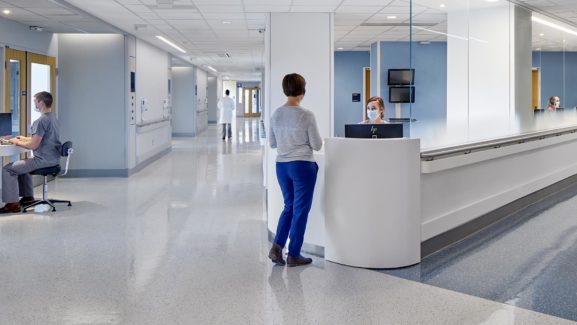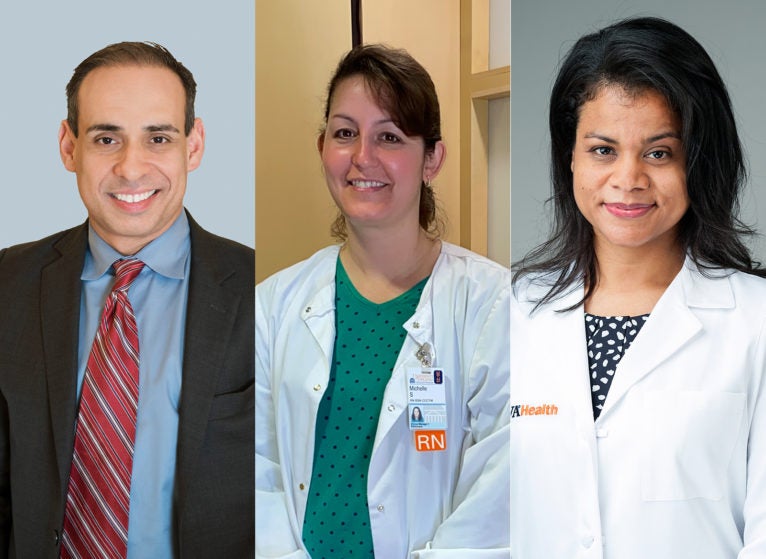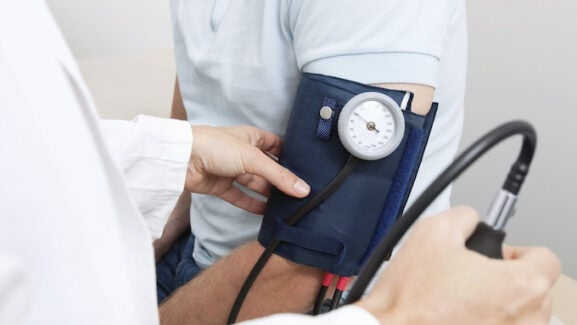

(l-r) Art Saavedra, MD, PhD, MBA; Michelle Sutton, BSN, RN; and Debbie-Ann Shirley, MD, MPH
One Year Later: In Standing Up the COVID Clinic, UVA Health Team Members Stood Tall
If there was an Olympic event or Super Bowl or World Series for speed-building a COVID clinic during a pandemic, UVA Health would have to be favored for the gold, the ring, or the trophy. In March 2020, only days after the first confirmed case appeared in the Commonwealth, we opened the doors to a new clinic that could serve our community. During an uncertain, chaotic time, team members from across UVA Health rallied to the cause. The task was enormous, the effort herculean, the dedication unparalleled.
Connect sat down with Art Saavedra, MD, PhD, MBA, Chair of Dermatology, Chief of Population Health and Health Policy; Michelle Sutton, BSN, RN, Clinic Manager-COVID, Infectious Disease/Traveler’s, and Pulmonary Clinics; and Debbie-Ann Shirley, MD, MPH, Head of Pediatric Infectious Diseases, to see what it was like creating the COVID clinic. Saavedra is the executive sponsor of the COVID clinic, Sutton is responsible for the oversight of staff and daily operations of the clinic, and Shirley is the clinic’s medical director.
What is the COVID clinic? Who does it serve?
Saavedra: The COVID clinic is our marquee outpatient clinic devoted to testing, novel therapy, and strategy around our patients who are not hospitalized. Our reach is across state lines, across various populations, and in collaboration with emergency room and inpatient units.
The first confirmed COVID case in Virginia was announced on March 7, 2020. Three days later, UVA Health had a COVID clinic up and running. Walk us through the timeline of what it took to do this.
Saavedra: First, we had to think hard and extrapolate what needs there may be. We had little information. We were learning every day about patterns of infection, epidemiology, contacts, and environments of care. At the beginning we considered issues around:
- Do we have enough testing kits available?
- How do we select who will be tested and why?
- How do we help people stay at home if they don’t need to come to the hospital and be tested?
- What are the best recommendations for patients if they test positive?
- How do we route patients through the hospital in order to prevent infection and spread?
- How do we keep our teams safe in the process?
- What protective equipment do we need?
- What precautions do we need in testing rooms (filters, air exchanges)? …
We took a very cautious approach. We created a team, mostly initially volunteers, committed to working together — willing to learn every day, to be flexible, to be willing to have things change every day. We were initially doing consultations to understand who would best benefit from testing. There were days we saw patients and tested none. As testing became more available — and our institution led the development of laboratory testing — we were able to ramp up services to the point of nearly 140 tests per day. We partnered with other groups, such as the Virginia Department of Health and Health and Human Services, to embark on protocols that would gain essential workers, and those without primary care doctors, access to testing. It was a new chapter every day!
What were the barriers you had to overcome? What did success look like, and how did you achieve it?
Saavedra: As above, we initially had limited access to testing and few protocols. We divided and conquered. Some of us concentrated on learning about regulatory processes, others perfected operations, others updated communications to the enterprise, and others staffed the clinics with compassion and dedication. It was a group effort.
Shirley: I agree, one of the initial barriers we faced at the start of the pandemic was limited access to diagnostic testing. We all had to be good stewards over a limited resource and carefully manage the best we could using prioritization strategies. That was hard, but now — thanks to the ingenuity of our laboratory colleagues and support from our leadership — testing capacity is much more robustly available.
Another challenge is that, one year ago, we really knew so little about the deadly virus that causes COVID. We have had to learn what this disease looks like and how to recognize patients who might be infected and, hence, need to be tested. At first, we thought the only symptoms were fever, cough, and difficulty breathing. But now we appreciate an ever-expanding range of clinical presentations that can be associated with COVID, both during and after infection.
We also didn’t understand fully how the infection was spread. Figuring out that infection could be spread even by people who are pre-symptomatic or asymptomatic was a real curve ball, as it complicated controlling spread a great deal.
We are still learning how best to manage patients with severe COVID, and so many unanswered questions remain but, as a medical and scientific community, we have accrued an incredible amount of knowledge over the past year. Every time there is a new change, our clinic goes back to look at our protocols and guidelines to see what we need to update — a process of continual improvement in the quality care we provide.
What did success look like? By taking care of patients, taking care of each other, and doing it safely.
What are the most important lessons learned from standing up this clinic?
Saavedra: Team work is essential in crisis management. And because our direction was not clearly defined, and things changed every day, we had to communicate frequently, honestly, and with openness to destroy the previous days’ work, to make it better tomorrow. Our teams taught me that UVA is a place where people really know what matters. Our staff was selfless, tireless, and came in every day wanting to make a difference. I am not going to deny that we often felt fear and exhaustion, but those feelings were overpowered by the absolute dedication for the task that lie ahead of us. We were all on a first-name basis. We started the day together in a huddle, and ended the day together in a huddle.
Sutton: I agree. Teamwork is essential, and you can’t over communicate.
Shirley: Absolutely. The power of teamwork.
What team highlights would you like to share?
Sutton: It has been amazing to start up a clinic, have that clinic evolve and pivot with changing guidelines and testing methods, evolve from a group of volunteer team members to a more permanent team, move that clinic to a new space in the middle of the pandemic, and continue to have team members dedicated to this work, who enjoy showing up every day and giving 100% of themselves, tirelessly and fearlessly. To know this team is to love them, and I have such a deep appreciation for each of them.
Shirley: In the past year, we have evolved into an efficient testing and diagnostic clinic serving both patients and team members with over 14,000 testing visits to date, and within the past 3 months we have opened up a monoclonal antibody infusion treatment program. We have additionally created patient education materials and written ambulatory standard operating procedures documents, supported COVID-related research studies, and trained team members from other clinical areas. Also, our RN triage line has answered more phone calls than we can count! Having our RN team serve as a resource by answering COVID-related phone calls has been one way to help communicate rapidly evolving information and changes throughout the pandemic.
What are you most proud of that the COVID clinic has accomplished?
Saavedra: We drove the protocols and algorithms that were later scaled for testing of pre-procedural and surgery patients. Also, we were one of the few sites in the state that could provide novel monoclonal antibody treatment to patients in order to prevent admissions to the hospital.
Shirley: I am actually proud of so many things that the clinic team has accomplished. I think the monoclonal antibody infusion program is one example, as our clinic team learned how to become an infusion center as soon as this therapy became available under an FDA emergency use authorization at the end of last year. With the support of leadership, IT, pharmacy services, infectious diseases specialist Dr. Patrick Jackson, and many others, we have developed unique expertise providing this therapy for patients with COVID who are at higher risk for progression to severe disease.
Has the COVID clinic evolved over the past year? If so, how? What does its future look like?
Saavedra: We have evolved from a consultative center, to a testing center, back to a care center, a primary care site, an infusion site, a site to perform innovative research, and a site of regulatory compliance. The skillsets that we have developed and our ability to be flexible has been a true accomplishment of the team. In the future, we will continue to test those who needs us, to collaborate with epidemiology in the hospital should there be any outbreaks in-house or in our communities, and to play a lead role in novel therapies and research.
Shirley: In addition, we are paying close attention to emerging variants to understand how we will need to adapt our clinic response, if these variants become more widespread within our community.
It’s been a difficult year. How have you managed stress and/or personal and family obligations? Any tips to share with team members?
Saavedra: We have celebrated with potluck lunches, Zoom meetings, and we have tried to laugh a lot. Michelle and Debbie-Ann’s leadership has been essential — and a pleasure to learn from. Finally, we were very open about our achievements and took every opportunity to improve. Celebrating small accomplishments can sustain a herculean effort. Validating the role of EVERYONE on the team was essential.
Sutton: It has been important for me to “remember my why” — why I became a nurse — to care for and serve others. And also reminding myself that we, as a community and as healthcare providers, are in this together. Our team has been fortunate to support one another and we have received community support as well.
Shirley: The pandemic has been fatiguing for everyone, and those who have stepped up to be part of the response team, in particular, are exhausted. Being able to acknowledge that you feel tired or overwhelmed is an important first step to managing stress. Considering some of the resources that have been put in place to help healthcare professionals cope is another. The promise that the COVID vaccines hold is giving many a second wind. But how do I manage stress? Believe it or not, for me, I usually feel refreshed after spending time in the clinic with our team. The enthusiasm, compassion, and dedication of this good-natured, hardworking group is always uplifting.
When COVID is over (or at least subdued) — and we shift back to a semblance of normal life — what are you most looking forward to doing?
Saavedra: I want to shake people’s hands again and hug patients who need it.
Sutton: Hopefully seeing people smile and returning smiles — without masks, if that is ever possible — and giving hugs PRN. [Editor’s note: “Pro re nata,” Latin for “as the need arises.”] Taking a cruise to celebrate my son’s 21st birthday. This was his birthday request this past November.
Shirley: Seeing kids back in school! The isolation of sheltering at home and virtual education has been such a toll on the mental health and wellbeing of children during the pandemic. As a pediatrician, I know that children are resilient, but they really are suffering in their own way, too. I can’t wait for all children to be back in school full time — back to growing, developing, and thriving to their fullest potential as social beings.
So many contributed to this effort, however any thank-you list would likely be overly exhaustive or unintentionally exclusionary. Knowing that: Are there any individuals or any groups to whom you want to give a shout-out?
Saavedra: Jamie Hughes (IT), Sherry McCarty (communications), Katie Fellows (Patient Friendly Access), Susanna Brent (communications), Michelle Sutton (nurse manager), Debbie-Ann Shirley (medical director), Amy Mathers (infectious disease physician) … and many, many others. Who did I miss?
Sutton: I want to specifically give a shout out to Bryan Chambers, an employee in Housekeeping, who has provided our COVID clinic staff with uplifting notes of thanks and encouragement that he places on our breakroom windows for our staff to read. I’d also like to give a shout-out to Dr. Josh Eby, who is Medical Director of Employee Health, for working so closely with our team to take care of our own employees in need of testing. Vickie Vess, Pod Supervisor. Adrienne Stimson, PFA Project Manager, who tirelessly worked alongside our team to write out protocols and processes for the clinic.
Shirley: Yes, there are really so many to thank and this is a good start with what Dr. Saavedra and Michelle have put together. I’d also like to add Dr. Melinda Poulter, Director of Clinical Microbiology; the entire HIT Epic group; Dr. Costi Sifri and the hospital epidemiology team; Dr. Patrick Jackson, Dr. Heather Cox and the rest of the monoclonal antibody pharmacy team; Dr. Ira Helenius, Dr. Kim Dowdell, and the many other providers who have volunteered their time. Also, I have to thank the UVA Children’s Hospital leadership team for allowing use of their Teen Health clinic space for the first months of our clinic start up, and all of the many other UVA team members who have helped us along the way.
What else should we know?
Saavedra: I want to thank all our patients for their patience, their support, and for teaching us to continue to strive to be better in the setting of uncertainty.
Latest News



